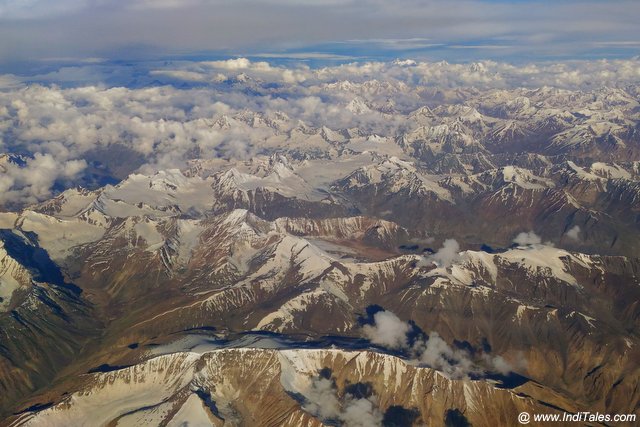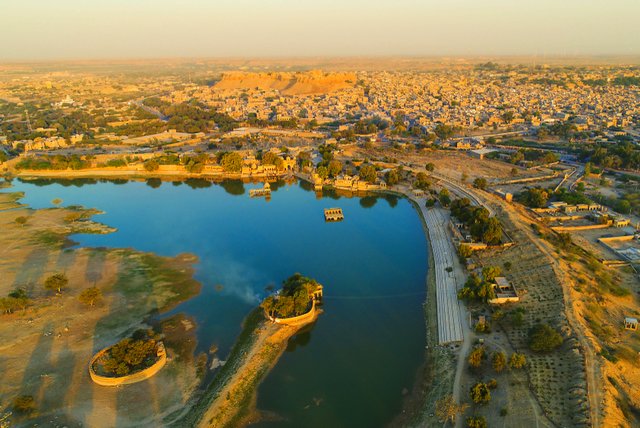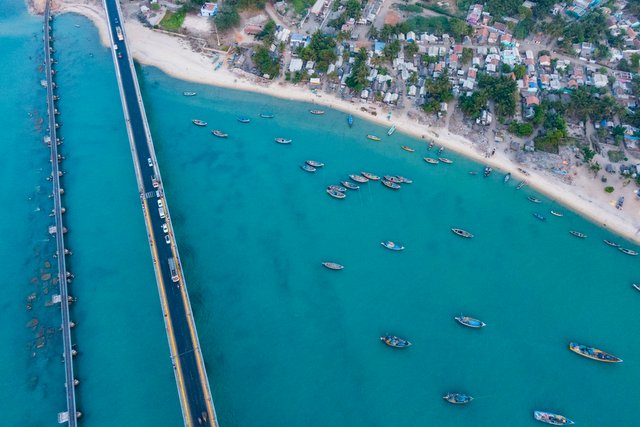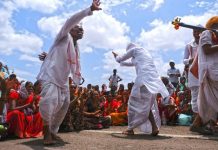India is an eternal poem. It is living breathing poetry. Poetry that thrives amidst its chaotic diversity, amidst the layers and layers of cultures it wears, living within the geographical boundaries defined ages ago. Political boundaries have changed a million times and would keep changing. But the boundaries of this nation and its consciousness are defined in its scriptures with the Himalayas in the North and the Indian Ocean in the South. It neither expands beyond that nor shrinks within these limits. It is a space holding the meditative energies of thousands of years of seekers who chose to live in its mountains, forests & on its riverbanks.

Aerial perspective of India
Be a bird or a cloud a la Meghdoot – the classic poem of poet Kalidasa, and see India from its perspective. In Meghdoot a lovelorn Yaksha sends the message to his beloved wife in the city of Alkapuri, somewhere deep in the Himalayas from the hills of Ramtek in central India through a traveling cloud just before the beginning of the monsoons. Lovelorn, he tells the clouds what to see as it travels to his beloved. He talks about the landscapes the clouds will see, the hills, rivers, flowers, flora, and the fauna. He tells the clouds about the cities like Ujjain where opulence is the norm and the forest people living on the path to Ujjain. It is as if the Yaksha himself is traveling back through that path. Even if it just in his imagination.
First Glance
A first glance from the sky would show India wrapped in a soft cover of sand and snow, with hills creating the folds that hold the forests where the likes of Lions, Tigers, Elephants, and Rhinoceros roam free with herds of deers jumping around playing hide and seek with them. A narrow strip of sand surrounds the peninsula along its long coastline, the longest anyone has in the world. Thar desert in the northwest entices with its mystical vistas full of sand dunes. Somewhere right in the central part, a fossil park holds the memories of the time this land was a part of Gondwanaland, and the forests here hold sand beneath their greenery.
Himalayas

The Himalayas sit like a snow-capped crown on the head of India. Its glaciers give birth to the many rivers running through the plains. Including the most revered ones – Ganga, Yamuna, and Sindhu. So, do the other hills be it Vindhyas of central India or Kodagu Hills in the South, or Sahayadris in the west. The place where the rivers originate becomes a pilgrimage. The place where they meet and become one becomes a pilgrimage. Finally, when they merge with the ocean on either side, that too becomes a pilgrimage.
Rivers
Rivers are like the veins in the body of India. They circulate waters that have nurtured civilizations on their banks for ages just like the blood nurtures our bodies. The only other thing that competes with the rivers running across the country is the railway tracks, passing through tunnels cutting across hills, connecting shores with bridges. And literally mapping the whole of the nation with train station codes.
Along the Gandaki river that borders Nepal, single-horned Rhinos that get their local name ‘Gainda’ from the river, roam around freely. Just as they do in the tall grass of Kaziranga in Assam. That is surrounded by the vast expanses of tea gardens that help Indians wake up every day.
In the waters of Ganga and Chambal Rivers live the river dolphins, Ghariyals – the national aquatic animals of the nation. Along the banks of Narmada, pilgrims can be seen walking with the river to their right, circumambulating it on foot, all 2800 km of it.
In the forests of central parts of the country, river-like Denwa or Panna are favorites to spot tigers when they come to quench their thirst. In the jungles of Pench, the stories of Mowgli and Shera come alive. Ganga near Rishikesh is home to herds of elephants just as Teesta nurtures them on its banks in the foothills of eastern Himalayas.
Kumbh Mela
At the given celestial positions, Kumbh Mela repeats every 12 years. It is the biggest confluence of the human race ever, that takes place at the confluence of Ganga and Yamuna at Prayagraj. It also happens at Haridwar where Ganga enters the plains. On the banks of Kshipra in Ujjain that is the zero Meridien of India. And on the banks of Godavari in Nasik. The rest of the year the Ghats of rivers at divine places like Ganga at Haridwar and Varanasi, the Yamuna at Mathura, the Narmada at Omkareshwar and Maheshwar, and the Godavari at Nasik are buzzing with activity as pilgrims come and pray.
On days like Kartik Purnima that come a fortnight after Diwali pilgrims take a holy dip in all the sacred water bodies across the country. World’s largest camel fair takes place close to the holy Pushkar lake in the city of Brahma.
If one were to zoom in a bit, the small Kathkuni temples, with alternate panels of stone and wood and slanted roofs in slate stone, dot the foothills of Himalayas in Himachal Pradesh and Uttarakhand. They are abodes of deities sitting on hilltops, overlooking the regions they protect. A million streams here join to form rivers like Sutlej and Beas. The high lakes like Chandratal in Lahaul or Nako in Spiti seem like they have descended from the heavens. They tell you a million stories of mystics who lived on their banks and shepherds who come every summer with their sheep.
Thar Desert of India

In the Thar desert of Rajasthan, also home to the favorite stone of modern-day builders – white marble and yellow Jaisalmer stone, the hill forts seem to be rising out of the sand. Matching its golden color, with camels roaming around joining the color scheme. The world’s second and third largest walls surround and secure the forts of Kumbhalgarh and Amer. Inside the forts, the colorful wall murals create a mélange that makes you feel royal the instant your step inside them. Staying in some of the palace turned hotels is living the true-blue royal lives of Rajasthan royalty.
Step-Wells
They are the ornate bowls smiling from the surface of Rajasthan and Gujarat. Resplendent in their symmetric and geometric steps, with stories of scriptures adorning the walls all around, is the famous step-wells. These step-wells made life possible in areas with no natural source of water and limited rainfall. Some of them like Rani ki Vav in Patan are seven stories below the ground. It gives you an impression as if they are leading you to the world below or maybe inside the womb of the earth. Just imagine the travelers sitting here to rest for a while. Or women in their colorful Odhnis sitting after a day’s work to chat and rest or collecting water.
A little south, Ajanta caves hold 2000 years old paintings telling stories of Buddhas and Bodhisattvas. Ellora caves hold the biggest engineering wonder of the nation. A monolithic temple carved upside down, scooping out everything that was not needed. Look at it and wonder when, where, and how did we lose the knowledge our ancestors had.
Khajuraho
Most of the temples in the north were lost to various invasions. But the temples of Khajuraho survived to give us a glimpse of royal temples as they existed for more than 1000 years back. They try to recreate the Kailash Parvat or Mount Kailash with the cascading north Indian Nagara style Shikharas. A style that is seen across the north of the nation and peaks in temples of Odisha. The city of stones with hundreds of Hindu and Jain temples have many stories to tell for the one who has time to listen. Best known for the erotic sculptures on their outer walls, they are poetry in stone with a rhythm of the music in its folds.
A little to the east, the thick forests of Dandakaranya find a mention in Ramayana. Even today you can see the tribal communities here worshipping trees with reverence deep inside thick forests.
Sita and Buddha
The current state of Bihar, the land of Sita in Ramayana and Buddha in our age, holds the stories of enlightenment of Buddha under the Bodhi tree at Bodh Gaya. Close to it is the ruins of Nalanda University in the brick red color spread telling you about the glorious days. That is when it attracted students from across the world. Including the most famous one – Xuan Zang, whose memorial can be seen next to the university. Quaint villages of Madhubani can be recognized from a distance with their painted walls of each house. An art form that has traveled from the dusty lanes of this rural landscape to the galleries around the world.
Monsoons in India
If one was to follow a monsoon cloud as it starts from the Southern tip of the nation in Kerala. At the peak of the summer season in June and follow it as it slowly moves north, soaking in the parched land desperately waiting for them to rain. This path would soak one in the essence of the nation as it soaks and nourishes its thirsty lands.

In Kerala, you see a thousand shades of green almost challenging your eyes to count the colors if you can. From the light green of a fresh banana plant to the dark green of a pepper vine wrapped around coconut trees. This is the land of spices. Be it the black pepper for which traders landed on India’s shores for ages. Or be it the cardamom, cinnamon, nutmeg, or cloves. The lush green forests are full of elephants, many of who come together to celebrate the big temple festivals. The water channels of backwaters of the Arabian sea cross-cross this land, like the no man’s land between the sea and the Indian peninsula.
Snake Boat
Right in the middle of the monsoons, men and women take out their long, narrow snake boats. To race in the backwaters as part of the Jalotsava or the Water Festivals of the temples here. Cutting through the waters celebrating the monsoons. Wooden temples tell these tales on the dark wood panels that looked soaked in coconut oil.
Poetry in stone
Little eastwards, in the Tamil country, live the biggest and probably the oldest poetry in stone. You are spoilt for choice, where to look and zoom in between Mahabalipuram, Kanchipuram, Thanjavur, Srirangam, and Chidambaram. Shore temple stands almost at the eastern edge, overlooking the waters of the Bay of Bengal. Looking at its sister temples beneath the waters, surrounded by the five Ratha temples named after the 5 Pandavas. A phenomenon that repeats across the landscape of the nation.
Largest Living Hindu Temple
It is an effort to take the eyes off the sculpted wall called Arjuna’s penance or Krishna’s butterball. But then you must look at the tall colorful gopurams of Shiva and Shakti temples trying to pierce the sky with Srirangam. It is the largest living Hindu temple complex in the world. It has 21 tall Gopurams surrounding its seven walls, almost a living city. Each temple containing walls after walls full of stories. Every little detail about the sculptures has a meaning for the one who understands. The bodies of humans or the divine are sculpted with perfection. It is hard to believe till you stand before them. You will wonder if they would start speaking.

They do speak, they tell you tales of their times. The exquisite jewelry, fine clothing, elaborate hairdos, and fashionable footwear all take you back to their times. Deities sit on their vehicles holding their icons. Ready to interact with you, bless you or just let you know they are there with you, within you. Tales from epic Ramayana and Mahabharata adorn the temple walls. No matter which part of India you are in. Ram Setu, an umbilical cord that still joins the island of Sri Lanka to India is seen at the narrowest distance between the two.
Coffee country
From the coffee country in Coorg flows the river Cauvery. Nourishing the southern peninsula on its way to the Bay of Bengal. The Kingdom of Mysore once flourished on its banks. One that is still famous for its Dussehra festival. In the Chalukyan land of North Karnataka, you can see the laboratories where temple carving was taught in Aihole, close to the almond colored caves of Badami and the unique architecture of temples of Pattadakal. Not too far from it are the ruins of the majestic and royal city of Hampi of the Vijayanagara empire. Probably the most beautiful ruins that you can see, of one of the richest cities the world has seen.
Godavari
Little above the Godavari meanders through the rice fields of Andhra. River Krishna nurtures the red hot chilies of Guntur, witness to ancient Amaravati that has resurfaced as the latest new city on the landscape. Little above in Odisha, Vishnu lives as Jagannath, surrounded by another set of exquisitely carved temples, caves amidst the artist who paint lovely stories. Konark Sun temple still maintains its chariot shape with well-carved wheels on all sides even in its ruined state.
Terracotta Temples
Move up to Bengal where in the absence of any stone, artisans baked the stories in terracotta tablets for the temple walls. Desperate to ensure that the stories are not lost to the next generations. The same stories are picked up by the weavers to weave on the famous Baluchari and Swarnachari Sarees. Hauntingly divine and at the same time rustic Baul music can be heard in the lanes of small towns and villages here. Including Shanti Niketan – the university set up by Rabindranath Tagore.
Brahmaputra
The north-east corner or the auspicious Ishaan Kone of the landscape is home to hundreds of tribes living on either side of the Brahmaputra river. This includes Majuli island on the Brahmaputra. The largest riverine island in the world. It is home to Vaishnav Shatras who keep the legacy of Shankar Dev alive. This is where nature is at its benevolent best. Thick green cover on the hills, fertile lands, and hills interspersed with lakes and forests, tall or deep waterfalls. And a series of hidden caves, wildflowers, and fruit orchards.

Sun temples at Modhera in West and Konark in East, some in the Northern hills whisper to you about the glorious days of the Sun worship. The one who provides rhythm to our lives with its cycle of day and night. In the heart of the country is Naimishararnya – the forest that gets a mention in every Indian scripture as the abode of sages. That is where the scriptures were discussed, debated, shared, and written. You can still find the trees that probably listened to them. A pilgrimage for anyone on the path of Dharma.
Finally, India as a consciousness still lives in the villages that are scattered across the country. Villages with lotus ponds, cattle sheds, platforms beneath the ancient trees. Where life is simple and elements of nature still sacred.
Like Martin Luther King said – To other countries, I may go as a tourist, but to India, I come as a pilgrim. Yes, it is a country where every hill, stone, river, lake is divine, and every traveler a pilgrim.
First published in Hinduism Today Magazine














Words can’t describe the article. So nicely described the beauty of India
Thank you Rohan.
Such beautiful photos + well-written article = satisfied reader
I love every bit of this article, Thank you!!
Lovely article, love this article Thanks for sharing this.
Lovely article, love this article Thanks for sharing this
Wow..! Amazing photos and beautifully narrated. ????
Thank you, Pradeep.
AMAZING POST…
Stunning..! Stunning photos.
Thanks for sharing those great photos
Great Share! Thanks for sharing.